Ed Gorman's Blog, page 31
July 13, 2015
Gravetapping: COMPOUND MURDER by Bill Crider
By Ben Boulden:
Compound Murder is the twentieth novel featuring
Blacklin County, Texas Sheriff Dan Rhodes. The
series started in 1986 with Too Late to Die, and
the latest title (number 22 in the series),
Between the Living and Dead , is scheduled for release
in August. Blacklin County’s population is small,
but the characters and crimes are anything but.
It opens with a burglary at the Beauty Shack.
The thief broke the restroom window, and stole
the Shack’s latest inventory items—
“…hair extensions and wigs. Made from
real human hair,” which have an impressive
treet value. Sheriff Rhodes’ report and scene
investigation are interrupted by another call.
A corpse is in the parking lot of the community college.
When Rhodes arrives the scene is being handled by
Dr. C. P. Benton; “Seepy” to everyone who knows him.
Dr. Benton isn’t a deputy, but he thinks he is, and he
is pretty sure the dead man was murdered—
“You’re sure it’s a crime scene?”
“That would be my professional judgment as
a graduate of the Citizens’ Sheriff’s Academy.”
As it turns out Seepy is right, and Rhodes quickly
identifies a handful of suspects. The victim was an
English professor, and not well liked. The primary
suspect is a student named Ike Terrell. Ike is a suspicious
character simply by relation. His father is Able Terrell
who is the leader of the county’s local survivalist group.
He has a compound, guns, and rumors of more guns.
The investigation is far from clear, and the plot is littered
with twists.
Compound Murder is smooth, humorous, and criminal.
It is a rural police procedural; mostly whodunit with a
shimmer of hardboiled. The humor is secondary to the
well-crafted mystery, and acts as a foil to the seriousness
of the crime. It is developed in the eclectic oddball
characters—the Abbot and Costello act of the police
dispatcher and jailer, and Rhodes’ straight man-like
reaction to it—and the dialogue, which hums with
misunderstanding. The stolen hair is a hot topic,
and provides a few well-placed laughs—
“‘That’s not a head,’ Rhodes said. ‘It’s a wig stand.
With hair on it. Real human hair, too, I’ll bet.’
“‘He scalped his victim?’
“Buddy’s voice trembled. Rhodes didn’t know
f the cause was excitement or disgust.
“‘No,’ Rhodes said. ‘His victim was Lonnie Wallace.’
“‘It was Lonnie Wallace’s body at the college?’
“Rhodes wondered why all his conversations
seemed to go this way. Maybe it was somehow
his own fault.”
Mr. Crider nicely develops the setting—the decaying
main streets of Blacklin County ’s small towns;
the heat; the country ’ s expanse. The places,
and many of the characters, flow from novel to
novel developing a strong sense of place in each,
and the series a whole. There are also a few insider
jokes: Joe Lansdale’s name shows up twice. Once
as a karate instructor, and again as a novelist.
Published on July 13, 2015 07:54
July 12, 2015
Fred Blosser looks at "The Lost World"--Cinema Retro
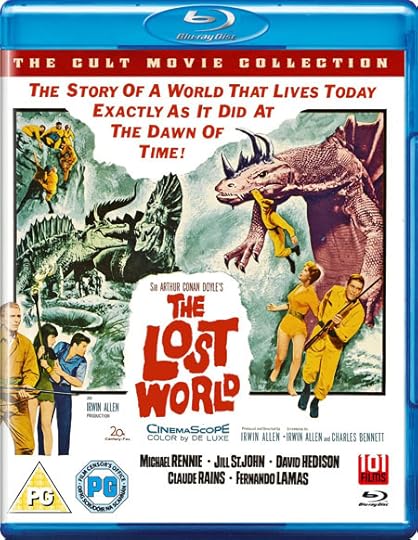
BY FRED BLOSSERWhen it opened in theaters some 55 years ago, on July 13, 1960, producer/director Irwin Allen’s “The Lost World” promised 96 minutes of exotic, CinemaScope, Color by DeLuxe fantasy adventure about dinosaurs and modern-day explorers in a remote corner of the world. As difficult as it may be for older filmgoers to remember today, and for younger ones to even imagine, widescreen cinematography and sumptuous color were powerful draws in that era before home theater, 500 cable channels, and streaming video. The TV set in your living room would only pick up three or four stations at best on a small black-and-white screen. A night out at the movies in CinemaScope and air conditioning was a big treat for most families. Talk about a lost world. Ten-year-olds were further primed by a Dell movie-tie-in comic book with its cover photo of a fearsome giant reptile emerging from a sinister fog: “Fantastic adventures of an expedition to a lost land of prehistoric animals and fierce headhunters!”
The enticements worked and Allen’s movie did good business, but its reviews failed to match its commercial success. The critics, who had little use for science fiction anyway in that era before the genre became big entertainment business, derided nearly every aspect of the film. Some of their points were valid. By filming on studio backlots and using stock footage to cut costs, Allen compromised the classy value of Winton Hoch’s expansive widescreen cinematography. The script by Allen and his frequent collaborator, one-time Alfred Hitchcock scenarist Charles Bennett, leaned heavily on conventional Hollywood plot elements to pad out Conan Doyle’s rousing but rather dramatically thin source material. Those might not have been serious liabilities five or ten years earlier, but Hollywood was already moving in the direction of greater realism, at least in terms of filming in authentic exotic locations rather than a sound stage. Most small-town audiences probably didn’t care, but their comments didn’t enter the permanent record. The newspaper and magazine reviews did. Today, compared with the level of lifelike detail that modern CGI can produce, the sets look even cruder in the jungle scenes.
Worse for special effects purists, Allen dashed hopes that the movie would employ the magic of stop-motion animation that had distinguished First National Pictures’ original, silent-screen version of “The Lost World” in 1925. Instead, as another way to save money and time, the production substituted tricked-out lizards for the ingenious, articulated model dinosaurs that Willis O’Brien had built and animated for the 1925 film. O’Brien was credited as a “technical expert” for the 1960 film, but the work really was done by Fox’s in-house team of L.B. Abbott, James B. Gordon, and Emil Kosa Jr. When “The Lost World” ran on TV from the late 1960s through the ‘80s, it suffered even further: pan-and-scan conversion ruined Hoch’s cinematography and made the artificiality of the sets even more apparent. It didn’t help that Allen recycled footage from the movie for his TV series “Voyage to the Bottom of the Sea” (1964-68) and “The Time Tunnel” (1966-67). The practice confirmed Allen’s critical reputation as a crass penny-pincher and may have conflated the movie with those childish TV shows in viewers’ memories.
In the film, scientist George Edward Challenger (Claude Rains) returns from an expedition to the wilds of the upper Amazon, where he claims to have found an isolated plateau on which dinosaurs have survived into the present. Not having any physical or photographic proof (his photos were lost when his canoe overturned on the return trip), and already regarded by his staid colleagues as an egotistical gadfly, he is met with disbelief. He proposes to launch a return expedition, joined by his skeptical rival Professor Summerlee (Richard Haydn) and globe-trotting sportsman Lord John Roxton (Michael Rennie). As a condition for financing the quest, newspaper magnate Stuart Holmes (John Graham) coerces Challenger into taking star reporter Ed Malone (David Hedison) along. Malone will file breaking-news dispatches on the way to the Amazon and beyond -- a prescient 1960 version of today’s reality TV and real-time internet coverage of sensational “infotainment.”
Flying to South America, as represented by the actors in close-up looking out of airplane windows at spectacular stock aerial footage of lush jungles and cascading waterfalls, the expedition reaches an outpost where they are met by guide Costa (Jay Novello) and helicopter pilot Gomez (Fernando Lamas). They also have two unwelcome additions. Holmes’ daughter Jennifer (Jill St. John), has impulsively jetted over without parental knowledge to join her boyfriend Roxton, accompanied by her brother David (Ray Stricklyn). From the outpost, Gomez’ chopper ferries the explorers to the lost plateau. There, a dinosaur wrecks the helicopter, stranding them. After adventures with other dinos, giant spiders, and man-eating venus fly-traps and voracious creeper vines, they are captured by a tribe of cannibals. A gorgeous native girl (Vitina Marcus) helps them escape through the perils of the Graveyard of the Damned and the Lake of Fire (did Lucas and Spielberg see this movie as teens and take notes?). There’s a subplot about a dark secret in Roxton’s recent past and a hunt for diamonds, leading to a confrontation with one of his fellow travelers in a grotto where a gunshot rouses another dinosaur, which eats the most expendable character in the cast. Getting rid of the monster by dumping a cascade of lava on it, the survivors flee the plateau just before the magma sets off a volcanic explosion.
The novel and the 1925 movie ended with Challenger taking a dinosaur back to London, where the creature escapes and causes panic (in the book, a pterodactyl, in the silent film, a Willis O’Brien T-Rex). Allen, in another cost-conscious move (or did he have thoughts about a sequel?), ends with a baby T-Rex, actually a gecko, hatching from an egg, and Challenger jovially promising to take it back as proof for skeptics.
Watching the movie now in a new, high-definition, 1080p Blu-ray disc released in Great Britain by 101 Films, the 2015 viewer is likely to agree with the critics of 1960 that the limitations imposed by Fox’s erratically thrifty budget make it difficult to settle comfortably into the story. The strangling creeper vines are about as convincing as the tentacles of Ed Wood Jr.’s rubber octopus in “Bride of the Monster” (1955). Even in 1960, and probably more so today when everybody can identify a picture of a T-Rex, no one except a three-year-old is going to accept a monitor lizard or a gecko as a tyrannosaur. There’s a passing joke in Steven Spielberg’s “The Lost World: Jurassic Park” (1997) that was probably meant, subliminally, to remind viewers about the presumed technical superiority of modern computer-based practices over older FX in Allen’s namesake movie and others. Eddie Carr (Richard Schiff) expresses surprise when he first sees Spielberg’s realistically detailed CGI dinos on Isla Sorna. “Well, what did you think you were going to see?” asks Ian Malcolm (Jeff Goldblum). “Animals,” Eddie says lamely. “Maybe big iguanas.” The lizards and the human actors are matched pretty well in “The Lost World” in a couple of scenes, but moviegoers demand more realistic effects in the “Jurassic World” era. There’s also the criticism that the use of lizards amounted to animal abuse in scenes where the real reptiles bite and claw each other in the dinosaur fights. Audiences in 1960 were probably not bothered, but it’s likely to give many of us pause in these more enlightened times.
Time has been kinder to other aspects of the movie. The scenes of Rains as the irascible Challenger verbally sparring with Haydn as the haughty Summerlee are little masterpieces of droll acting that fans of dry British humor are likely to enjoy. Too bad the two actors never had a chance to reprise their roles in a sequel, but Haydn and another veteran of classic British stage and screen, Sir Cedric Hardwicke, played similar characters two years later in Allen’s “Five Weeks in a Balloon” (1962). Where yesterday’s critics jabbed at Jill St. John’s heiress plunging into the rain forest in an outfit better suited for a suburban pool party (“Jill St. John, as the daughter of the backer of this junket, is dressed in tight-fitting fuchsia pants and is as out of place here as a manikin in a mudhole,” the New York Times review sniffed), today’s retro fashion admirers are likely to get a charge out of the ensemble. At that, modern reality-show fans would hardly be fazed if the Kardashians or the Hilton sisters appeared in the same get-up on “Celebrity Survivor.” It’s always a pleasure to see classy old-school actors like Rains, Haydn, Rennie, Cinema Retro favorites David Hedison and Jill St. John, Lamas, Novello, and Stricklyn.
The Blu-ray disc from 101 Films is immaculate, the widescreen image and rich colors stunning. This is the best that “The Lost World” has looked since its initial big-screen run. The only extra feature on the disc, which will play only on all-region or Zone B players, is a chapter menu.Posted by Cinema Retro in DVD/Streaming Video Reviews & News on Sunday, July 5. 2015
Trackbacks
Published on July 12, 2015 13:21
Tom Piccirilli R.I.P. from Locus
Writer Tom Piccirilli, 50, died July 11, 2015.Thomas Edward Piccirilli was born May 27, 1965. He published over a dozen ambitious and accomplished crime and horror novels, notably Stoker Award winner The Night Class (2003) and The Cold Spot (2008), a finalist for the Edgar Award for best paperback original mystery. He was an accomplished author of bleak and quirky short fiction as well, with many collections, including World Fantasy Award finalist Deep into that Darkness Peering (2000). His story “The Misfit Child Grows Fat on Despair” (2002) won a Stoker Award. Piccirilli was also a prolific poet who produced many volumes, among them Stoker Award winners A Student of Hell (2000) and Forgiving Judas (2014). He edited and co-edited numerous anthologies, including Stoker Award-winning poetry anthology The Devil’s Wine (2004).Piccirilli was diagnosed with a brain tumor in 2012, and suffered a stroke in 2014. He is survived by his survived by his wife, writer Michelle Scalise.See the August issue of Locus for a complete obituary.- See more at: http://www.locusmag.com/News/2015/07/...
Published on July 12, 2015 08:26
July 11, 2015
James Resoner reviews John Hegenberger's TRIPL3 CR0SS

It's 1988, and small-town P.I. Eliot Cross is searching for his long-lost father. Then, a CIA informant says that Dad has been in deep cover for over twenty years. Now, the informant's been murdered and Eliot is on the run.
Scrambling to clear his name, Eliot journeys from Washington D.C. to Havana, Cuba, struggling against deadly drug-runners, syndicate hit-men and his own violent nature. But the worst is yet to come, as Eliot discovers his father is at the center of an international conspiracy, a nuclear threat and a double cross...or is that a triple cross?
Veteran author John Hegenberger spins a yarn that is both an exciting thriller and a compelling piece of "noirstalgia", expertly recreating a sense of late-Eighties paranoia and double-dealing and painting a vivid picture of Washington and Cuba during that era, as well as saving a shocking twist for the very end. TRIPL3 CROSS is pure reading entertainment.
Published on July 11, 2015 13:39
Tom Piccirilli has died
When Rich Chizmar told me this this morning I almost refused to believe it. Tom and I have been friends since the early 90s. We have a two part novel coming out sometime this year. He was a wonderful guy and a honestly brilliant writer. He had been battling brain cancer on and off for at least three years. My best to his wife Michelle.
Published on July 11, 2015 10:19
July 10, 2015
Gravetapping: NIGHTCRAWLERS by Bill Pronzini
Purchase a copy on Amazon.
 The Nameless Detective series has been active since 1971 and it is still strong—in sales and quality alike. The protagonist—Nameless, who isn’t as nameless as he once was—has aged and matured in almost real time. He was young and full of fight throughout his appearances in the 1970s and 80s, but with age he has mellowed with creaky bones, aching muscles, a wife and an adopted daughter.
The Nameless Detective series has been active since 1971 and it is still strong—in sales and quality alike. The protagonist—Nameless, who isn’t as nameless as he once was—has aged and matured in almost real time. He was young and full of fight throughout his appearances in the 1970s and 80s, but with age he has mellowed with creaky bones, aching muscles, a wife and an adopted daughter.The thirty-second title, published by Forge in 2005, is Nightcrawlers and while it, and all of the recent titles, is different from the early Nameless stories it is still pretty damn terrific. In many ways the latest releases are better—there is more nuance, the execution is tighter and Nameless—or Bill—has developed into something more than he was. He is a living, breathing, believable character that is not only sympathetic to the reader, but downright likable.
Nightcrawlers is a personal journey for Nameless. There are three storylines that run parallel, and not one of them ever crosses another—there are no hokey connections or ridiculous coincidences, but rather there are three stories (mysteries) compressed with superb execution and sharp prose into one very enjoyable novel.
Nameless’ detective office is a three-person operation now. Nameless has semi-retired, Tamara Corbin is a full partner and Jake Runyon is the main operative. The location of the office has also moved—it is now just south of Market instead of the old O’Farrell Street location.Business is slow; Tamara is taking care of what seems to be a small skip-trace on a deadbeat dad, Jake is pursuing a non-paying case in an attempt to stop a string of brutal beatings in the Castro and Nameless is doing a personal favor for a dying pulp writer—Russell Dancer who appeared in at least three earlier Nameless novels (Undercurrent, Hoodwink and Bones), and is based on the pulp writer J. M. (Jay) Flynn.
The skip-trace turns out to be more than it first appeared and not because of the case itself, but rather something Tamara stumbles across as she is working it. Unfortunately Tamara never gets the opportunity to tell either Nameless or Runyon her suspicions before she disappears, which acts as the catalyst for the climax of the novel.
Nightcrawlers is damn entertaining. It is written in both first and third person—Nameless acts as his own narrator and the chapters in the perspective of Tamara and Jake are in third person. It works very well. It broadens the scope of the story without diminishing its personality. The perspective changes from chapter to chapter are easily detected (beyond the note at the top of each chapter) by subtle shifts in style and vocabulary. Tamara has the easy flow of the street, Jake is hardboiled, and Nameless is just Nameless.
Tamara: “Now that she was here, out on a field job, she began to feel a little stoked.”
Jake: “The man himself was in his late thirties, short, dark, and cynical. The cynicism showed in his eyes, the set of his mouth, his voice.”
Nameless: “Russ Dancer, dying. Cirrhosis and emphysema. Refused to quit drinking or smoking, refused hospitalization or treatment beyond painkillers and an oxygen bottle that he carried around with him.”
The prose has the deceptive feel and flow of simplicity, but, in its stark hardboiled style, it is vividly saturated with the essence of the characters and their city, San Francisco. The setting is developed well and described in a fashion that it makes the reader feel like she is in San Francisco moving between Market and Castro and all points between. The story builds upon itself with each page and chapter bringing with it a dry and edgy suspense.
Nightcrawlers is the real thing and a terrific entry in the series. Find a copy, read it, and pass it on because more people should be exposed to both Bill Pronzini and his other “Bill,” known as Nameless.
This review originally went live May 7, 2012. It was the first review I wrote for Gravetappingafter a long hiatus, and I decided it was worth running again. Nightcrawlers was the first “modern” Nameless novel I read, and since then I have been reading each title as it is released. I have even reviewed a couple: Strangers, and Nemesis .
Published on July 10, 2015 13:59
A major Stark House discovery
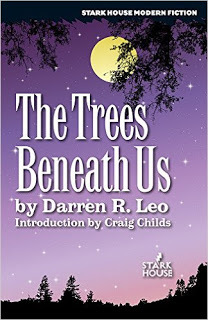
"His debut novel is simply brilliant. It is humorous and poignant and above all else, it is an important novel everyone should read." -- Charlie Stella, author of Eddie's World, Johnny Porno, Rough Riders"Against all reason, against his will, a man must begin a slow tumble back to the light after a loss no one should have to endure. Darren Rome Leo's new voice in fiction is not a breath of fresh air: it's a triumphant shout. The Trees Beneath Us may never be a classic, but it should be." -- Jacquelyn Mitchard, Oprah's Book Club author of The Deep End of the Ocean"D.R. Leo writes with the fluency of thought. His direct and unadorned sentences can skip gracefully up a forest trail or tunnel into the mind's dark recesses. Before you know it, they've taken you to some place wholly familiar, and yet entirely strange." --Richard Adams Carey, author of The Philosopher Fishand Raven's Children"From the first step onto the trail to his last words on the page, Darren Leo writes about healing, grief, and the intersection of the two with the authentic voice of someone who knows both. The Trees Beneath Us is a book that helps us understand what challenges us to go on, what gives us strength, and when we’ve had enough suffering to walk back into our lives." – Ann Garvin best selling author The Dog Year"Darren Leo's sterling prose and dramatic sense of incident make this hike on the Application Trail a philosophical adventure that gives voice to cries from the heart." - Merle Drown, author of Plowing Up a Snake and The Suburbs of Heaven
"Finn is on a mission which he himself chooses not to label. Sometimes it's a battle. Sometimes there are moments of gentle purity. There is also grim humor here. It took me on a trip I had never been on before."—Greg Shepard, publisher of Stark House Press
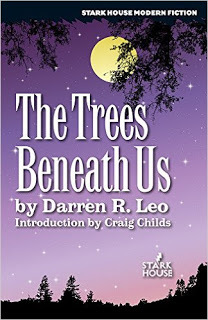
Published on July 10, 2015 07:40
July 9, 2015
An early De Palma thriller takes a Hitchcockian crack at sister bonding
An early De Palma thriller takes a Hitchcockian crack at sister bonding

By Jesse Hassenger@rockmarooned Jul 9, 2015 12:00 PM


 38 Comments
38 Comments Every day,
Watch This
offers staff recommendations inspired by a new movie coming out that week. This week: It’s Siblings Week at The A.V. Club, so we’re recommending movies about sisters.Sisters (1973)These days, it’s difficult to discuss Brian De Palma without mentioning Hitchcock. That would not have been the case in 1973, when De Palma’s Sisters came out on the heels of some oddball comedies he made with a young Robert De Niro. But the first of De Palma’s mainstream thrillers catches up in no time, riffing on Hitchcock films from three previous decades in just 90 minutes. As its story twists and turns, Sisters emulates elements of Rope, Rear Window, and Psycho. (Hitchcock’s only film of the ’70s to this point, Frenzy, had just been released the previous year.)Those reference points don’t spoil anything; part of the fun is watching De Palma recombine Hitchcock plots with his own voyeuristic obsessions. The latter are apparent from the start, when Danielle (Margot Kidder) meets Phillip (Lisle Wilson) on the hilariously unlikely yet still vaguely plausible game show Peeping Toms; she pretends to be blind, undressing in from of Phillip as hidden cameras film them, and participants bet on his reaction. He excuses himself like a gentleman, but they go out together afterward—and woe betide the De Palma hero who appears on a game show where one of the prizes is a set of cutlery.Danielle first mentions her sister only in passing; it’s only during the beginning of a sex scene, as the camera pushes in from an overhead shot to find the scar on her midsection (Bernard Herrmann’s score shrieking in the background, naturally), that the film reveals her status as a formerly conjoined twin, now separated from her counterpart Dominique. Dominique remains offscreen for much of the movie, but her presence lingers as Grace (Jennifer Salt), Danielle’s neighbor in Staten Island (where a surprising majority of the movie is set) starts to notice something strange afoot.De Palma is more interested in thriller mechanics than exploring sisterly dynamics; the relationship between Danielle and Dominique doesn’t have much detail beyond its broad outlines, delivered largely via expositional video footage. But Sisters does portray a familial bond so intense—and further intensified by male oppression and attempted domination—that it manifests even when the two sisters are apart. That aspect alone gives the movie a creepy charge, enhanced by De Palma’s skill in turning the Hitchcockian screws on his characters. Frequent homages, a couple of great split-screen sequences, and gruesome violence: What more could a De Palma fan ask for?Availability: Sisters is available on Criterion DVD, which means it’s also streaming on Hulu Plus. It’s also available for rental or purchase from other digital outlets.
Every day,
Watch This
offers staff recommendations inspired by a new movie coming out that week. This week: It’s Siblings Week at The A.V. Club, so we’re recommending movies about sisters.Sisters (1973)These days, it’s difficult to discuss Brian De Palma without mentioning Hitchcock. That would not have been the case in 1973, when De Palma’s Sisters came out on the heels of some oddball comedies he made with a young Robert De Niro. But the first of De Palma’s mainstream thrillers catches up in no time, riffing on Hitchcock films from three previous decades in just 90 minutes. As its story twists and turns, Sisters emulates elements of Rope, Rear Window, and Psycho. (Hitchcock’s only film of the ’70s to this point, Frenzy, had just been released the previous year.)Those reference points don’t spoil anything; part of the fun is watching De Palma recombine Hitchcock plots with his own voyeuristic obsessions. The latter are apparent from the start, when Danielle (Margot Kidder) meets Phillip (Lisle Wilson) on the hilariously unlikely yet still vaguely plausible game show Peeping Toms; she pretends to be blind, undressing in from of Phillip as hidden cameras film them, and participants bet on his reaction. He excuses himself like a gentleman, but they go out together afterward—and woe betide the De Palma hero who appears on a game show where one of the prizes is a set of cutlery.Danielle first mentions her sister only in passing; it’s only during the beginning of a sex scene, as the camera pushes in from an overhead shot to find the scar on her midsection (Bernard Herrmann’s score shrieking in the background, naturally), that the film reveals her status as a formerly conjoined twin, now separated from her counterpart Dominique. Dominique remains offscreen for much of the movie, but her presence lingers as Grace (Jennifer Salt), Danielle’s neighbor in Staten Island (where a surprising majority of the movie is set) starts to notice something strange afoot.De Palma is more interested in thriller mechanics than exploring sisterly dynamics; the relationship between Danielle and Dominique doesn’t have much detail beyond its broad outlines, delivered largely via expositional video footage. But Sisters does portray a familial bond so intense—and further intensified by male oppression and attempted domination—that it manifests even when the two sisters are apart. That aspect alone gives the movie a creepy charge, enhanced by De Palma’s skill in turning the Hitchcockian screws on his characters. Frequent homages, a couple of great split-screen sequences, and gruesome violence: What more could a De Palma fan ask for?Availability: Sisters is available on Criterion DVD, which means it’s also streaming on Hulu Plus. It’s also available for rental or purchase from other digital outlets.


Published on July 09, 2015 13:15
July 8, 2015
The Making of The Magnificent Seven
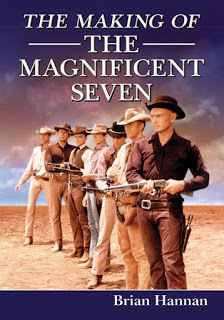
from the great website http://www.classicfilmtvcafe.comBook Review: The Making of "The Magnificent Seven"In his new book The Making of The Magnificent Seven:Behind the Scenes of the Pivotal Western, author Brian Hannan provides a fascinating look into how the 1959 Western classic reached the silver screen. He also makes a compelling argument that John Sturges' remake of Akira Kurosawa's Seven Samurai should take its place alongside the more critically-acclaimed Westerns made by John Ford and Howard Hawks.
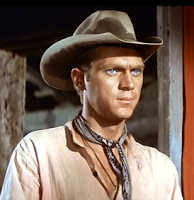
McQueen removed his hat nine times to draw attention to himselfHannan divides The Making of The Magnificent Seveninto three parts: (1) the "movie's long genesis"; (2) the actual production and an analysis of the film; and (3) a brief discussion of its release and enduring appeal. The most engrossing chapters are those that deal with its production history.
"It was Anthony Quinn's idea," writes Hannan in his book's first chapter. That alone is likely a revelation to most of the film's fans. Quinn saw Seven Samurai in 1956 and came up with the idea to remake it as a Western. He mentioned it to Yul Brynner as a possible starring vehicle for the two of them. Over the next three years, The Magnificent Seven's journey to the screen would take many unexpected twists along the way.
Hannan meticulously charts Brynner's rise to stardom and his desire to direct. Originally, the actor was set to direct and star in The Buccaneer (1958). In fact, according to a Variety article (quoted by Hannan), Brynner wanted to pull out of the film as its star and only direct, "but DeMille wouldn't have it." Ironically, Anthony Quinn, who was DeMille's son-in-law at the time, was credited as director (although how much he directed vs. DeMille has been debated).
The Spanish poster emphasizes
the numeral "7."Brynner's and Quinn's plans for The Magnificent Seven hit a major snag when the two discovered that screenwriter Lou Morheim had already bought the remake rights for $2,500 in 1957. Brynner's production company eventually negotiated a deal with Morheim for the rights (the latter is listed as an associate producer in the credits of The Magnificent Seven). Quinn was still interested in starring in the Western, but his salary and billing demands were too great. He eventually dropped out of the production.
Hannan goes to on to explain how John Sturges became attached as director, how the script was penned by six (or seven!) screenwriters, and how one of cinema's greatest casts was assembled. The author notes that the "final piece of 'casting'...was the recruitment of Elmer Bernstein to write the score." Amazingly, Bernstein was not the first choice as the film's composer. He joined the project after Dimitri Tiomkin, Aaron Copeland, and Alex North were considered and rejected.
Hannan's analysis of The Magnificent Seven focuses largely on Sturges' directorial style and a discussion of the film's themes ("Men in professions which cannot change are forced into inevitable collision with an altered world--that, in a nutshell, is the proposition of The Magnificent Seven").
I don't agree with the author's assessment that The Magnificent Seven marked the end of the Ford/Hawks Western era and "sowed the seeds for the films of Sergio Leone, Sam Peckinpah, and Clint Eastwood." The 1950s Westerns of Anthony Mann, Budd Boetticher, and Delmer Daves had already paved that road. And while it's a stretch to state that "The Magnificent Seven can certainly lay claim to being the most loved Western," there is no doubt that it remains one of the most popular (as evidenced by its frequent TV broadcasts).
The Making of The Magnificent Seven (McFarland & Company, 277 pages) contains numerous photos, extensive footnotes, a bibliography, and an index. Its strongest virtue is the detailed history of the production. For that reason, we strongly recommend it for fans of The Magnificent Seven. It will also be an engrossing read for any film buff interested in the convoluted processes that go into the making of a movie.
McFarland & Company, Inc. provided a review copy of this book.
Posted by Rick29 at 6:05 AM 7 comments

Email ThisBlogThis!Share to TwitterShare to FacebookShare to Pinterest
Labels: book reviews, rick29 (author), the magnificent seven, the making of the magnificent seven
Reactions:
Published on July 08, 2015 12:12
July 7, 2015
A GREAT interview with Max Allan Collins about Mickey Spillane
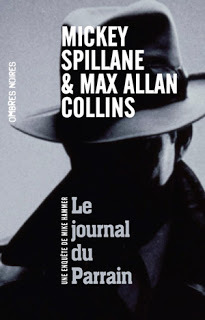
The interview will appear in this French edition
Interview with Max Allan Collins
It’s in the BookYou wrote the end of a story by Mickey Spillane, who passed away in 2006. You were friends, how did you two meet?
As a young teenager, I idolized Mickey and wrote him dozens of fan letters. He never responded until I published my first novel, BAIT MONEY, in 1973, and sent him a copy, He wrote me a warm, lengthy letter of welcome to the community of professional writers.
Over the years I have been a defender of Spillane, who remains controversial in the United States. Because of that, I was asked in 1981 to be the liaison between Mickey and the Bouchercon mystery convention in Milwaukee, where he was a guest of honor. We immediately hit it off and I began to visit him at his home in South Carolina once or twice a year.
How did you come to complete his manuscripts?
On my various visits to Mickey’s home, he would send partially completed manuscripts home with me. He said this was just because he thought I’d be interested, but on one occasion he said, “Maybe we can do something with these someday.” He was referring to two partial Hammer novels, THE BIG BANG and COMPLEX 90. We had begun to collaborate on projects – a number of noir anthologies of his work and the work of others, a science-fiction comic book called MIKE DANGER, and a biographical documentary I wrote and directed, “Mike Hammer’s Mickey Spillane.”
When Mickey became ill, with a particularly virulent strain of cancer, we stayed in close touch by phone. He was working desperately to finish what he described as the last Mike Hammer, THE GOLIATH BONE. Shortly before his death, he called and said he didn’t think he’d be able to finish it. And he asked me to do it for him, if that proved necessary. I of course said yes.
Around the same time, Mickey told his wife Jane to gather all his unfinished material and give it to me – “Max will know what to do.” No greater honor could be paid me. There were six major Hammer manuscripts, often with notes, and another half dozen shorter Hammer novels in progress. There were also short openings for novels, running from six to ten pages, that I thought would make good short stories. “It’s in the Book” is one of those.
You wrote several stories from his manuscripts. What did you like in this one in particular?
It had a beautifully written opening, with two cops coming to see Hammer in his office, to take him to see a U.S. Senator for some mysterious, important job. Mickey’s manuscript ended before that job was fully described by the client, and that enabled me to use the missing ledger that made the story a bibliographic mystery. You see, editor Otto Penzler had requested that specific kind of story.
What sort of shape did the manuscript have – was it just a few lines, a structure, several chapters?
It was basically that opening, right up to where Hammer meets with the senator. I thought it was a lovely, traditional opening for a private eye story.
It must be a very special experience, and a challenge, to finish a story more than 20 years later. Did you try in any way to modernize the style, the story, or anything – or did you try to remain faithful to Spillane’s style?
I’ve done seven Hammer novels now, and the unfinished Spillane manuscripts spanned his entire career – from 1947 to the month he died. I always try to determine when Mickey was writing the story, and then I immerse myself in material that he wrote around that same time, so I can catch the flavor and capture Hammer at that specific time. Hammer is a much changing character, and a story conceived by Mickey in the ‘50s is vastly different from one written in, says, the 1980s. I don’t try too overtly to mimic Mickey’s style — it’s collaboration, not pastiche. I concentrate on getting Mike Hammer right. It’s a matter of character.
I am a very traditional, Old School mystery writer, so this comes naturally to me.
Did he influence you in your writing, or help you in your own work?
Mickey was a huge influence on me. The key writers for me were Hammett, Chandler, Cain, Thompson and Westlake. These are very different writers in their approaches, and I think having such variant influences has worked well for me. Mickey never really gave me any writing advice – I was already a pro when our friendship developed. But he was supportive and provided blurbs for many of my book covers.
What is it that makes the character of Mike Hammer so special, compared to other popular characters?
Hammer had an enormous impact on popular culture worldwide, well beyond the private eye genre. James Bond is a version of Hammer, for example. Prior to Hammer, detectives did not display the emotions – love, hate, fear – that Spillane gave his hero. Hammer was the first avenger of modern fiction, a hero who used the methods of the villain to triumph over that villain. In addition, Hammer as a combat veteran brought a traumatic backstory to the detective, much imitated since. Finally, Hammer slept with women, unashamedly. While Sam Spade had sex with his femme fatale, just about no detective since had done so. Chandler said disparaging things about Mickey, but after the success of the Mike Hammer books, Marlowe began having an active sex life.
Say what you will about Mickey, but he was the most influential mystery writer of the 20th century…and the bestselling, with the possible exception of Christie.
How did you come up with the idea of this ending?
That idea jumped to mind at the outset. I knew it was a good one. Mickey loved surprise endings, and this was right up his alley.
Are you yourself interested in rare books and first editions?
I am. I have a good collection with many signed books – all the writers I mentioned above, and more. I have a very strong Rex Stout collection, for instance.
What do you enjoy most about writing short novels?
I’m not a short story writer by inclination. I’m very much a novelist. But I’ve grown to like the form. It’s nice to have a project that lasts a week and not several months. My wife, Barbara Collins, is an excellent short story writer.
Who are the authors that inspire you today? Why?
I read very little contemporary fiction. I don’t care to be influenced by trends, and anyway my reading time is taken up largely by research for my historical thrillers. I continue to read and re-read the greats – again, Hammett, Chandler, Cain, Spillane and so on.
Do you read French thrillers?
I’m very traditional on that front, as well – Boileau-Narcejac. Jean Pierre Melville is one of my favorite film directors.
Published on July 07, 2015 12:45
Ed Gorman's Blog
- Ed Gorman's profile
- 118 followers
Ed Gorman isn't a Goodreads Author
(yet),
but they
do have a blog,
so here are some recent posts imported from
their feed.



